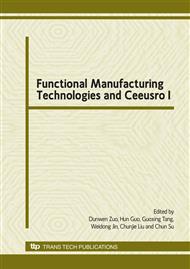p.648
p.653
p.658
p.664
p.668
p.674
p.678
p.683
p.687
Numerical Simulation of Hydrodynamic Fluid Pressure in Grinding Zone with Resin-Bonded Diamond Grinding Wheel
Abstract:
In the grinding process, grinding fluid is delivered for the purposes of chip flushing, cooling, lubrication and chemical protection of work surface. Lubrication and cooling are the most important roles provided by a grinding fluid. Hence, the conventional method of flood delivering coolant fluid by a nozzle in order to achieve high process performance purposivelly. However, hydrodynamic fluid pressure can be generated ahead of the grinding zone due to the wedge effect between wheel peripheral surface and part surface. In the paper, a theoretical hydrodynamic pressure modeling is presented for flow of coolant fluid through the grinding zone in flood delivery mode in the surface grinding using resin-bonded diamond grinding wheel, which based on Navier-Stokes equation and continuous formulae. The numerical simulation results showed that the hydrodynamic pressure was proportion to grinding wheel velocity, and inverse proportion to the minimum gap between wheel and workpiece and the maximum pressure was generated just in the minimum clearance region in which higher fluid pressure gradient occur. It can also be concluded the pressure distribution was uniform in the direction of width of wheel except at the edge of wheel because of the side-leakage.
Info:
Periodical:
Pages:
668-673
Citation:
Online since:
January 2010
Authors:
Price:
Сopyright:
© 2010 Trans Tech Publications Ltd. All Rights Reserved
Share:
Citation:


